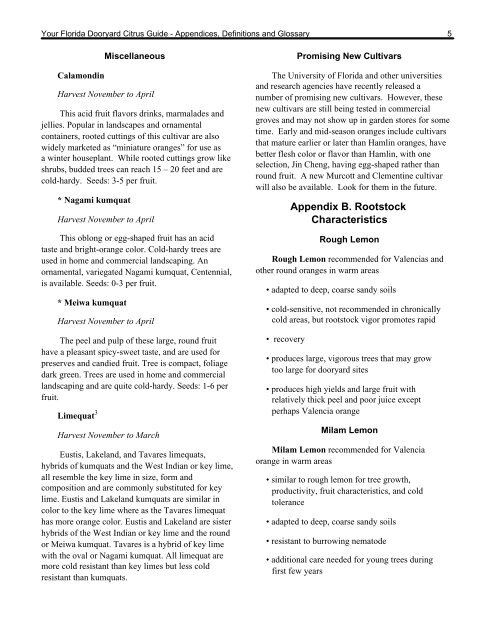Dooryard Citrus Guide - Appendices, Definitions and Glossary
Dooryard Citrus Guide - Appendices, Definitions and Glossary
Dooryard Citrus Guide - Appendices, Definitions and Glossary
Create successful ePaper yourself
Turn your PDF publications into a flip-book with our unique Google optimized e-Paper software.
Your Florida <strong>Dooryard</strong> <strong>Citrus</strong> <strong>Guide</strong> - <strong>Appendices</strong>, <strong>Definitions</strong> <strong>and</strong> <strong>Glossary</strong> 5<br />
Calamondin<br />
Miscellaneous<br />
Harvest November to April<br />
This acid fruit flavors drinks, marmalades <strong>and</strong><br />
jellies. Popular in l<strong>and</strong>scapes <strong>and</strong> ornamental<br />
containers, rooted cuttings of this cultivar are also<br />
widely marketed as “miniature oranges” for use as<br />
a winter houseplant. While rooted cuttings grow like<br />
shrubs, budded trees can reach 15 – 20 feet <strong>and</strong> are<br />
cold-hardy. Seeds: 3-5 per fruit.<br />
* Nagami kumquat<br />
Harvest November to April<br />
This oblong or egg-shaped fruit has an acid<br />
taste <strong>and</strong> bright-orange color. Cold-hardy trees are<br />
used in home <strong>and</strong> commercial l<strong>and</strong>scaping. An<br />
ornamental, variegated Nagami kumquat, Centennial,<br />
is available. Seeds: 0-3 per fruit.<br />
* Meiwa kumquat<br />
Harvest November to April<br />
The peel <strong>and</strong> pulp of these large, round fruit<br />
have a pleasant spicy-sweet taste, <strong>and</strong> are used for<br />
preserves <strong>and</strong> c<strong>and</strong>ied fruit. Tree is compact, foliage<br />
dark green. Trees are used in home <strong>and</strong> commercial<br />
l<strong>and</strong>scaping <strong>and</strong> are quite cold-hardy. Seeds: 1-6 per<br />
fruit.<br />
Limequat 3<br />
Harvest November to March<br />
Eustis, Lakel<strong>and</strong>, <strong>and</strong> Tavares limequats,<br />
hybrids of kumquats <strong>and</strong> the West Indian or key lime,<br />
all resemble the key lime in size, form <strong>and</strong><br />
composition <strong>and</strong> are commonly substituted for key<br />
lime. Eustis <strong>and</strong> Lakel<strong>and</strong> kumquats are similar in<br />
color to the key lime where as the Tavares limequat<br />
has more orange color. Eustis <strong>and</strong> Lakel<strong>and</strong> are sister<br />
hybrids of the West Indian or key lime <strong>and</strong> the round<br />
or Meiwa kumquat. Tavares is a hybrid of key lime<br />
with the oval or Nagami kumquat. All limequat are<br />
more cold resistant than key limes but less cold<br />
resistant than kumquats.<br />
Promising New Cultivars<br />
The University of Florida <strong>and</strong> other universities<br />
<strong>and</strong> research agencies have recently released a<br />
number of promising new cultivars. However, these<br />
new cultivars are still being tested in commercial<br />
groves <strong>and</strong> may not show up in garden stores for some<br />
time. Early <strong>and</strong> mid-season oranges include cultivars<br />
that mature earlier or later than Hamlin oranges, have<br />
better flesh color or flavor than Hamlin, with one<br />
selection, Jin Cheng, having egg-shaped rather than<br />
round fruit. A new Murcott <strong>and</strong> Clementine cultivar<br />
will also be available. Look for them in the future.<br />
Appendix B. Rootstock<br />
Characteristics<br />
Rough Lemon<br />
Rough Lemon recommended for Valencias <strong>and</strong><br />
other round oranges in warm areas<br />
• adapted to deep, coarse s<strong>and</strong>y soils<br />
• cold-sensitive, not recommended in chronically<br />
cold areas, but rootstock vigor promotes rapid<br />
• recovery<br />
• produces large, vigorous trees that may grow<br />
too large for dooryard sites<br />
• produces high yields <strong>and</strong> large fruit with<br />
relatively thick peel <strong>and</strong> poor juice except<br />
perhaps Valencia orange<br />
Milam Lemon<br />
Milam Lemon recommended for Valencia<br />
orange in warm areas<br />
• similar to rough lemon for tree growth,<br />
productivity, fruit characteristics, <strong>and</strong> cold<br />
tolerance<br />
• adapted to deep, coarse s<strong>and</strong>y soils<br />
• resistant to burrowing nematode<br />
• additional care needed for young trees during<br />
first few years
















